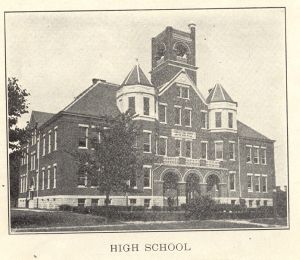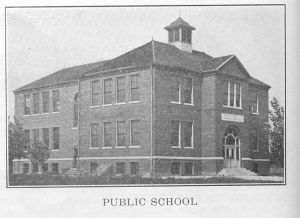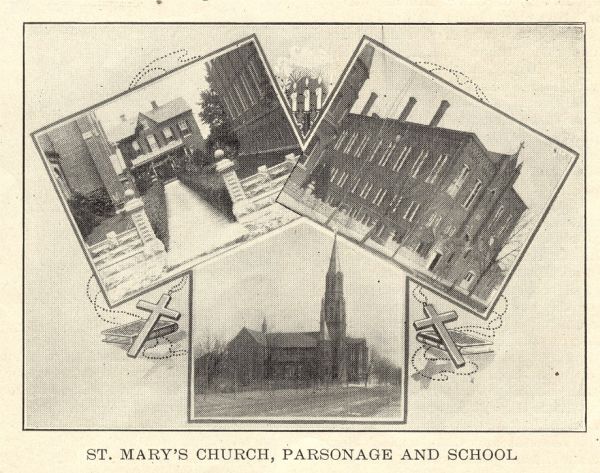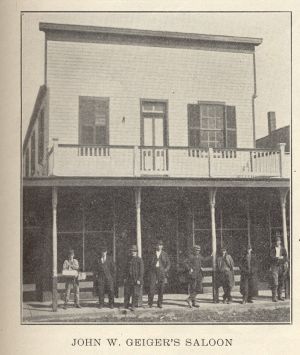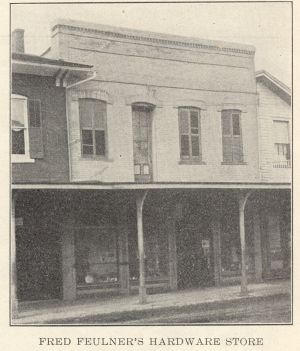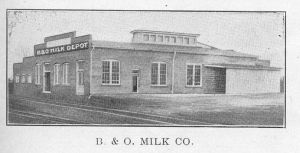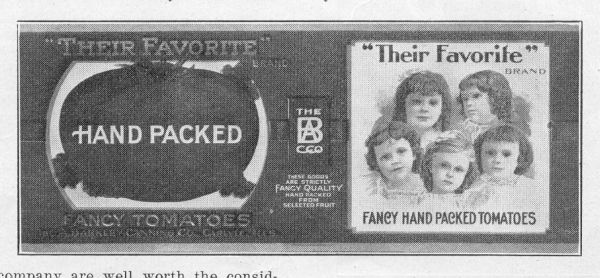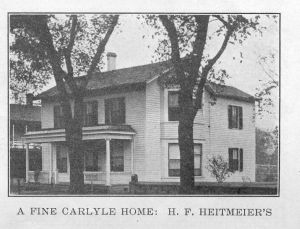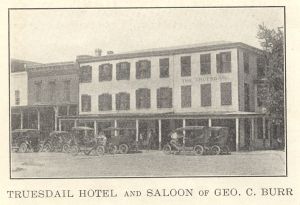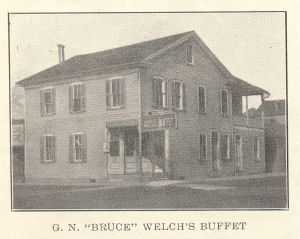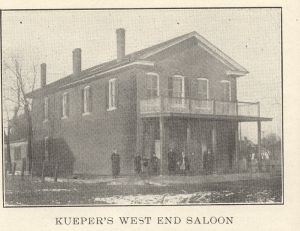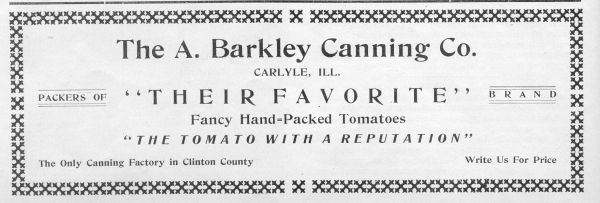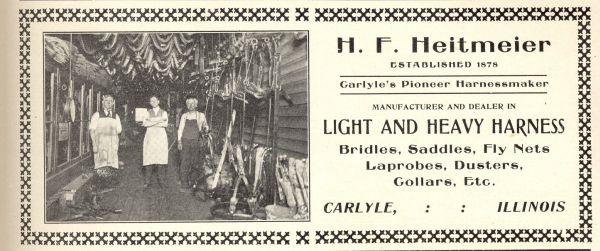|
Page 32 |
|
|
The early history and settlement of Carlyle dates back fully a century, and antedates the admission of the State of Illlinois into the Union. The first settlers were of English birth or parentage. Hence the name they gave it, Carlyle in honor of Sir Thomas Carlyle, of England, who was then so dear to every English heart,
and who in the eighteenth century had figured so prominently in literature and matters of state in the mother country. These, however, were not the only pioneers of the wilds of the west, which this then was. There were the sons of Georgia, the tall and athletic Kentuckian, the fearless backwoodsman from Tennessee, the Knickerbocker, the Buckeye, as also the representative of the Old Dominion, so proud of his birth and his own native State. To these hardy pioneers do the present generation owe a debt of gratitude hard to cancel. In short the enjoyments now realized by this generation, the well-to-do farmer, the merchant, the lawyer, the doctor, the banker and the tradesman in every craft - they owe to those fearless pioneers who braved every hardship, underwent every inconvenience, faced the wild Indian, and blazed the way for the incoming tide of immigration and civilization that now dots our land from the Atlantic to the Pacific. The efforts of these hardy few, are written not only in our histories, but more unmistakably engraven upon every highway in the land. From the best information the first white man who struck a blow toward civilization in Carlyle township was a pioneer by the name of John HILL, in about 1812. He built a log fort, or block house, a little north and west of Dr. KNAPP's dwelling, which a long time ago, in 1882 was situated in Lower Town, on Fairfax street. Mr. HILL, likewise, established a ferry near where the suspension bridge now spans the river. On the west side of the rived he erected a rude pole cabin for temporary use at |
the ferry. This cabin and the block house were the first houses, or steps towards civilization in Carlyle. In 1816 the brothers Charles, Richard and Thomas SLADE, located at Carlyle having bought the claim of Mr. HILL. Charles SLADE married a daughter of John KAIN, from which union several children were born. Richard, a son of Charles, and son-in-law of Joseph BREESE, went into the Mexican war, and died at Santa Fe, New Mexico. The first general mercantile store was opened by the SLADE Brothers, Richard and Thomas. They, in partnership with a man named HUBBARD, bought a stock of general merchandise and located it in a storeroom situated in the Lower Town, block 3, Fairfax street. Charles SLADE became one of the most prosperous and influential men of Carlyle settlement. In 1831 he was chosen member of Congress to represent this part of the State. On his return home from Washington in the Spring of 1832, when near Vincennes, Indiana, he was taken suddenly sick with the cholera and died in a few days. Another old settler was John CLABAUGH, who came to Carlyle in the Fall of 1828. He carried the U.S. mail from St. Louis to Vincennes. Carlyle was at that time very small indeed. Only a stray house here and there dotted its confines. The first school house was built by popular subscription in about 1828 or 1829. It was a small frame building, weather boarded with split shakes or clap-boards, rived out for the purpose. This house was also used for holding church services in. Later on in 1838 it was converted into a smoke house by Thomas BOND, in 1880 it went up in smoke itself. The first blacksmith was David DOW; John KAIN kept the first hotel. Charles SLADE in 1829 built the first water grist mill. It was an unpretentious affair, having but one run of stone, but it was the best at that time of any other of
its kind for miles around. It was destroyed by fire in 1831, but was rebuilt immediately thereafter. A wooden bridge used to span the river just above the mill where |
|
Page 33 |
|
|
the suspension bridge now crosses. It went down in 1830. The first blooded stock was introduced into Carlyle township in 1839 by a man named MCVICKER. He imported several cows of the Durham breed, some of which he sold for $300.00 per head. Carlyle proper was platted in 1825, and the deed thereof placed on record on the fourth of July. It was created a County Seat, by act of the Legislature of 1824, which act formed a new county to be known as Clinton and of which the primitive settlement Carlyle was designated the capital or county seat to be. The village of Carlyle was not incorporated until 1837. Its first elective officers were, John M. WEBSTER, President, and J. Bradley CLARK, Clerk. One of the first acts of these officers was to ascertain the number of inhabitants of said town, then found it to contain about 167 souls. The first brick house to be erected in Carlyle proper was by Franklin HEWEY. This was in 1838. The city hall, a substantial brick structure, was completed in 1880. A public library and reading room was established in 1872, by means of private subscription. Since we have related briefly the beginning of Carlyle, let us now turn to the present city. It is a thriving town situated in the most fertile county of the State of Illinois. Carlyle has many business institutions. It has several manufacturing plants, a large flour mill, three grist mills, two saw mills, several general merchandise stores, two large drug stores, one real estate firm, eight saloons, and many other business enterprises of a general character. When the oil boom was on in Carlyle in 1910, there were many prospectors in the city looking for leases and for some time Carlyle presented a very busy aspect. The Ohio Oil Company bought nearly all the leases of independent owners and now control the entire field. It owns an area of three and one-half miles and lies in sections 2, 3, 9, 10, and 11 of Wade Township. Above |
the old state road near the river. Another landmark is the TRUESDAIL House, one of the oldest buildings, still being operated as a hotel. It was built in 1858 by Robert TRUESDAIL. At that time it was a small structure, but as the town grew the owners decided to add to the building and now it covers more than one hundred feet front. It is on the north side of the square, facing the Court House, an ideal location. When Robert TRUESDAIL died in 1885 Clare E. TRUESDAIL and Lydia FISK, daughters of Robert TRUESDAIL took possession of the hotel and they have managed it successfully ever since. Today the fourth generation is living within the hotel. Many notable men of the State, among them Abraham Lincoln, Stephen A. Douglass, Horace Greeley, Gordon Bennett and others sojourned at this hotel during the year 1858 when the Lincoln-Douglass debates were at their height. Carlyle has been honored with several notable persons. It has been the home and is the burial place of Judge Sidney BREESE, who in fact has had a national reputation as one of the foremost jurists of the west. Ned Buntline, the novelist, once published a serial literary periodical here, entitled the "Carlyle Prairie Flower." The city at this time numbers upward of 2,000 inhabitants and has all the facilities that go to make it a pleasant and beautiful place of abode. St. Mary's Church The first and oldest Catholic congregation of Clinton County is Germantown; next in age and number is the congregation of Carlyle. The early settlement of Carlyle dates back about a century. The first settlers were of English birth and parentage, hence the name they gave it - "Carlyle," was in honor of Sir Thomas Carlyle of England. In 1853, Father FISCHER, of St. Mary's congregation, |
|
|
|
|
161 wells have been sunk and 75 tanks have been erected. The company employs thirty men, many of whom live on the property. The oil is pumped from the wells into tanks thence to the pipe line into Sandoval. From there it is pumped into the main pipe line and sent to Wood River. This pipe is six inches interior diameter. About 1,500 barrels of oil are pumped daily from the fields. Among the many interesting and historic places in Carlyle may be mentioned the old HUNTER Hotel, built on |
Jasper county, visited Carlyle and held services in the residence of Mr. TIGHE, who then owned the MUND Farm; now owned by SCHLAFLY Brothers. Father FISCHER found seventeen Catholic families. He encouraged them to build a church and the late Honorable Sidney BREESE, for many years Justice of the Supreme Court, donated the block of ground, on which the church was built. Father FISCHER invited Bishop Van De VELDE, who in the same year, laid the corner stone of a neat brick church. After the |
|
Page 34 |
|
|
church had been built, there was no money for a floor. Mr. TIGHE, now of St. Louis, Missouri, collected fifty dollars among his friends, and the late Peter MURPHY collected the remainder, and the floor was put in. From 1855 services were held in the new church. The mission was visited for a time by Father FISCHER and also by the good Jesuit Fathers of St. Louis, especially Fathers PATCHOSKI and DAMEN. The first pastor appointed to Carlyle was Father HAMMERLING, but as he did not reside in Carlyle, the late Father REINECKE, of Breese, Illinois, attending to sick calls, etc. The first resident pastor was Father MARSHALL, who came to Carlyle in 1858 and remained but one year. On August 18th, 1859, Father SIEGHARDT was appointed resident pastor for Carlyle. He, however, had to attend to Lebanon and missions at Centralia, Odin, Salem and Vandalia. In the beginning Father SIEGHARDT had a very hard time, there being no school and no parsonage. The congregation grew rapidly, however, and the energetic pastor soon had a school and a parsonage built. The church was no longer large enough to accommodate the parishioners and in 1867, Father SIEGHARDT built a new church, 120X66 feet; the old church was converted into a school, making two fine school rooms. In 1873 he built a new parsonage, and in 1873 he called the Venerable Sisters, "The Poor Handmaids of Jesus Christ," to take charge of the parochial school. In 1874 Father SIEGHARDT was succeeded by Rev. Father A. DEMMING. The erection of a large school house, at a cost of Twenty Thousand Dollars, and the following bad years, caused a great many difficulties in the financial condition of the congregation. In 1889, however, the members of the congregation showed their good will, after raising a good crop, by giving Eight Thousand Dollars to reduce the indebtedness of the congregation. On the sixteenth day of March, in the year 1904, after a short illness, Rev. Father A. DEMMING departed this life. Rev. J. B. DIEPENBROCK, of Cairo, Illinois, was appointed his successor. He entered upon his duties on the tenth day of April, 1904. The late Mrs. Julia SPARKS, widow of the late Honorable William A. J. SPARKS, helped the new pastor materially, to pay off the indebtedness of the congregation, giving him a check for eight thousand dollars for that purpose, and in addition thereto, donating one thousand dollars for three memorial windows. On the twenty-eighth day of April, in the year 1904, a terrific cyclone destroyed the church, leaving nothing standing but the steeple and a part of the sanctuary. All was in ruin. The good people of the congregation did not become discouraged. On the first Sunday after the disaster, they subscribed the neat sum of twenty-three thousand dollars, to rebuild the church. On the eleventh day of July, 1906, the Rt. Rev. Bishop JANSEN, dedicated the new church in the presence of about forty priests and a large concourse of people. The cost of the building and the furnishing of the new church was about sixty thousand dollars. Its seating capacity downstairs is seven hundred and fifty-four; in the gallery one hundred and fifty. The parish school is still taught by the Venerable Sisters of the "Poor Handmaids of Jesus Christ." And is attended by about one hundred and ninety children. In 1910, the good late Mrs. Julia SPARKS bequeathed thirty thousand dollars for a hospital and Old People's Home. The trustees bought the LUCAS place, one of the finest locations in the city, for twelve thousand dollars, and a neat hospital and old people's home now adorns the place; the hospital has twenty-two spacious rooms and a chapel; the sisters of the "Poor Handmaids of Jesus Christ" have charge of it. The congregation comprises about two hundred and ten families of German nationality, and about forty families of Irish nationality. The congregation is divided into the following sodalities: |
The Married Men's Sodality, with 150 members; the Married Ladies' Sodality, with 130 members; the Young Men's Sodality, with 125 members, and the Children of Mary, with 140 members. The congregation possesses a fine cemetery, containing twenty-five acres of ground. The present rector was born in Everswinkel, Westphalia, on the eighteenth day of August, 1852, and came to the United States of America on the twentieth day of August, 1878. He entered the Saleslanum, new Milwaukee, and was ordained priest on the twenty-fifth day of June at Alton, Illinois. His first mission was in Arcola, Douglass County, from which place he conducted about fourteen missions. In the year 1884 he was appointed Chaplain of St. John's Hospital in Springfield, Illinois, and on the eighth day of November, 1886, he was sent to St. Joseph's Congregation, Cairo, Illinois. In 1904 he was sent to Carlyle. The assistant, Rev. Father N. DIETRICH, was born in Kefferhausen, Eichsfield, on the eight day of July, 1865. He was ordained priest on the twenty-ninth day of June, 1890, at Lowain, Belgium, and came to this country on the tenth day of September, 1890. Rev. Father N. DIETRICH was the first pastor of Cahokia. Alex. HAAG Located on Fairfax street, the main street in Carlyle, is the meat market conducted by the above named. He has been located in Carlyle in the same business for 37 years. He is one of the pioneers of the city and is proud of the fact that he is one of the oldest business men in the County Seat. He was born in Baden, Germany, in the year 1856, and came to the United States in 1873. He was married in 1879 to Wilhelmina SCHMIDT and is the father of nine children, all of whom are living. The family consists of five boys and four girls, ranging in ages from 32 to 11. Mr. HAAG is the oldest butcher and stock buyer, in point of service, in the city and buys and sells live stock of all kinds. He also manufactures sausages of all kinds and lard, and kills practically all of his own meats. His meat market is the largest in the city and has the most select of patronage. Albert, one of the sons, is assistant in the shop and is one of the managers of the business. A. Plack CARR A. Plack CARR has attained unusual prominence for a comparatively young man in his calling as a lawyer. He was born and reared at Trenton, which place is still his home. After literary courses at McKendree College and |
|
Page 35 |
|
|
the University of Illinois, he graduated from Yale University Law School with honors at the age of twenty-one. He was then admitted to the bars of the States of Connecticut and New York. Coming to Illinois as soon as he had taken these examinations, he took the bar examination of the State of Illinois and immediately started to practice law in Carlyle, where he has been ever since, becoming a member of the law firm of FORD, CARR and JONES. He assisted Mr. FORD as States Attorney until Mr. FORD went out of that office in 1908. This partnership was dissolved in 1910 by Mr. CARR being appointed Assistant State's Attorney under H. V. MURRAY, under the firm name of MURRAY & CARR. This connection was severed in the latter part of 1912, when Mr. CARR opened up offices for the practice of law in the Farmers' & Merchants' Bank Building at Carlyle. In addition to being Corporation Counsel for the City of Breese, he is at present City Attorney of Trenton, and attorney for the villages of New Baden, Beckemeyer, Keyesport and Summerfield. John W. GEIGER Mr. GEIGER is one of the oldest saloon men in the city. He has been engaged in the business for the past 11 years. For several years previous to that he was engaged as helper and bartender for Phil ROBERT. When the latter died in 1902, Mr. GEIGER bought out the business from the estate and has conducted it ever since. The saloon is located on Fairfax street west of the Court House and is one of the best patronized saloons in the city. Highland draught beer is sold as is all kinds of bottled beer, wines, whiskies and cigars. There are card tables for customers, and a restaurant adjoining that is open day and night for the accommodation of patrons. Mr. GEIGER operated the restaurant three years and has put it on a paying basis. He was born in the county in 1876 and has lived there all his life. He is a son of Mathias and Anna GEIGER who have been residents of the county for over forty years. He was married twelve years ago to Bertha HADERLEIN, who died December 5, 1907,
leaving with him two children, two girls. Mr. GEIGER is one of the best saloon men in the city and is rapidly |
climbing the ladder of success owing to his excellent business management and his honest way of doing business. Fred FEULNER In 1884 the above named bought out the stock of W. S. MARRIOTT, who was then in the hardware business in a small way in Carlyle. Today the store is one of the largest hardware stores in the county. It is the only exclusive hardware store in the county at present. Mr. FEULNER settled in Carlyle in 1868, having come from Germany. For a time after that he traveled around the country and also worked for a time in Missouri. He returned to Carlyle in 1884 at the age of 27 years and started into business for himself. He deals in exclusive hardware, including heavy and shelf hardware, stoves, tinware, guttering, spouting, tinning and plumbing. He also sells electrical supplies. Mr. FEULNER carries a stock of merchandise valued at $5,000 and does a yearly business estimated at $20,000. He was elected an Alderman four years ago and served as Alderman four years before that, there being an elapse of several years between the two elections. He is one of the best known business men in the city and has a host of friends in and around the city. His business is constantly growing and there is a reason. His methods are honest weights and courteous treatment. He was born in Germany in 1856 and is a son of Andrew and Elizabeth FEULNER. His mother lived in America seventeen years with Fred, but the father died in Germany. He is one of eight children, four of whom are living in different parts of the United States. One is still in Germany. Mr. FEULNER was married in 1881 to Martha BASLER, a native of Bond county. C. P. NORRIS Mr. C. P. NORRIS and his wife have been conducting stores in Carlyle for several years. They started into a business of selling groceries, queensware, etc., in 1871, that is C. P. NORRIS did himself. For many years he operated the business alone. He was married in 1875 to Mary F. BLACK, she died in 1895 leaving three children. In 1897 he married Marjorie DONALD who later became a partner in the concern which today stands out as one of |
|
Page 36 |
|
|
the leading concerns in the city. His second wife is a native of Scotland and lived for many years in Carmi, Ill. In one store, which is under the management of Mrs. C. P. NORRIS, a full line of ladies' fancy goods and millinery is displayed. The combined stock of both stores is estimated at $3,500.00 and a yearly business of over $20,000.00 is done. Mr. NORRIS
was born in Carlyle in 1853 and is a son of Dr. W. and Mathilde NORRIS. His father died in 1861 and his mother passed away in 1885. His parents settled in the county in 1835 and were among the very first to locate in Clinton county, he is one of three children all of whom are living. Mr. NORRIS was educated in the county and has a host of friends. He owns several farms near Carlyle which he rents and which pay him big dividends yearly. His business is increasing rapidly, necessitating the erection of a new store building which was recently completed. |
STRATHMAN, The Photographer Through the courtesy of J. STRATHMANN, the reproductions have been published in the buildings of Carlyle. He is the only photographer in the city and the finest in the county. He also has the largest studio. It is located on West Main street in what is known as the West End. He has been in business in Carlyle for the past ten years, having moved to the County Seat from Germantown where he had been located for 13 years. He still maintains a studio at that place. He has been in the county 24 years and hails from St. Libory, where he was born in 1858. For several years before locating in Germantown he traveled all over the counties of Clinton, St. Clair, Bond and Washington in a wagon taking pictures. Finally he settled in Germantown and began to make a success of his business until today he has no equal in the county for excellence of work done. He does general photographing, enlarging, framing and portrait work. Also develops Kodak films and makes a specialty of taking views and post cards. He was married in 1887 to Mary DIEKER of Kansas, and has 11 children, five girls and six boys, all living. Their ages range from 25 years to 7 months of age. Only one of the children are married, a son, he lives in Palmyra, Mo. One daughter is in a convent at Belleville, and the rest of the children are either at school or working in Carlyle. Lawrence SCHILLING In 1896 the above named bought out the interests of B. BOND, an implement dealer of Carlyle, and has since made the business a success. He sells the John Deere, John I. Case and Oliver implements, John Deere and International Harvester wagons and the John Deere, Anchor and John D. Manley buggies. He also handles cream separators and farm machinery. In 1910 he added automobiles to his stock and at present is agent for the Mitchell, Overland and Hudson cars, and also handles supplies for all makes of machines. He does electric wiring in connection and sells all kinds of electric appliances. During the year 1911 he sold eleven automobiles. He was born in Belleville in 1864 and is a son of Michael and Johanna SCHILLING. His father died in 1911, but his mother is still living. He is one of ten children. He was married in 1903 to Annie ADAMS, who was born and raised in Carlyle. Mr. SCHILLING received his education in the Carlyle schools. He was Tax Collector for four years and is well known and respected in the county. His business is the largest of its kind in the city. B.&O. Milk Co. One of the largest manufacturing concerns in the city is the B. & O. Milk Company located on the B. & O. tracks east of the depot and owned by a company of Carlyle business men. George GRAY, is the president and manager; Herman BECKEMEYER, vice-president, and H. V. MURRAY, secretary and treasurer. Mr. MURRAY, at present States Attorney, is one of the organizers of the company. It was started in 1905 as the B. & O. Condensing Company and changed to the present name in 1908. Mr. GRAY has been with the company since 1906. Mr. BECKEMEYER has been connected with the company the same length of time. W. S. LOUDEN and Elmer GINZEL were connected with Mr. MURRAY when the company was organized. At present the company is condensing milk; the capacity of the plant is 15,000 pounds daily. The greatest part of its product is shipped to the Union Dairy Company in St. Louis, while some of it goes to Centralia and Olney. Within a short time the company is planning to can milk and then it will be sold to the trade. The company is incorporated for $60,000. It was incorporated in 1905. Six employes are engaged to do the work at present. A new building is planned and it will cover a space 90X120 feet and will be built of concrete blocks. Mr. GRAY, the president and manager of the plant, is a native of the |
|
Page 37 |
|
|
county, having been born here in 1866. He is a son of John Norman GRAY and grandson of Findlater GRAY, who were among the pioneers of the county. His mother was
born in Scotland. Mr. GRAY received his education in the schools of the county and was married in 1895 to Emma KONRAD. One child was born to the couple, a son, who is seventeen years of age. Mr. GRAY is one of eight children, only four of whom are living. The A. BARKLEY Canning Co. Carlyle can justly be proud of its canning factory; indeed the A. BARKLEY Canning Company would be a credit to any city. It was established in 1907 and is located about one mile from the corporation line in the Northwestern part of the city. The company owns and controls 80 acres of ground around the factory on which they raise tomatoes for their own use, although they buy many tons every year extra. The plant has a capacity of 15,000 cans a day during the season which runs August 1st to October 1st. The firm employs a force of 30, mostly girls. The company makes a specialty of selling its produce direct to consumers, although in some cases the retailer and a few wholesalers are sold. It is planned to work up a consumers' trade exclusively. The tomatoes |
"Leader," "Cinch," and "Snow Flake" 5-cent cigars; and "Tampa Vana," a 10-cent cigar. The capacity of the plant is 15,000 a month and a ready sale is found for every cigar turned out in the factory. There are four employes in the factory, they are: Frank, William, Sr., Rosie and J. D. KUEPER. Mr. KUEPER as born in the county in 1873 and is the son of William Sr., and Annie KUEPER, and is one of eight children. He was educated in the county schools and was married 13 years ago to Annie SCHLUETER, of Breese. They have four children, all living, whose names are: Leona, John, Verena and Albert. The territory of the firm covers the entire county and
parts of St. Clair and Washington counties. The factory is located opposite the Catholic church and is one of the finest buildings in the city. Tobacco was harvested from 1,295,000 acres of land in 1909, being an increase of one hundred persent in thirty years. |
|
|
|
|
canned by this company are well worth the consideration of any family who care to use tomatoes at all. They are the best canned tomatoes on the market today. "Their Favorite" is the name of the leading brand. It may be found in every store in the City of Carlyle. During the season of 1912 the company could have shipped more only for the scarcity of tomatoes. Mr. A. BARKELY manages the plant. Their display ad will be found on another page of this history. J. D. KUEPER Another one of Carlyle's manufacturers is the above named. He is a manufacturer of cigars, operating the largest factory in the county. He has been in the cigar business ever since he was a boy. His father was engaged in the business in Carlyle for many years before he was born. The present owner has been in business since 1895, having succeeded his father as manager. Only the very best of cigars are manufactured, among them being the following brands: "La Caroline," "Katy Lee," |
|
|
Page 38 |
|
|
George C. BURR One of the most up-to-date saloons in the city is conducted by the above named. It is located in the west end of the TRUESDAIL Hotel building and is managed by one of the most progressive business men in the city. In October, 1912, Mr. BURR bought out the interests of Fred OBERMEIER. He handles the Anheuser-Busch beer exclusively on draught, but sells a great deal of all kinds of bottled beers, wines, whiskies and cigars. Mr. BURR is the newest saloon man in the city. He has lived
in the county for the past twenty-five years and was born in Boonsville, Mo., in 1862. He was married in 1885 and is the father of five children, all of whom are living. He is
|
the son of William E. and Harriet BURR. His parents are natives of Lexington, Ky. Mr. J. E. HELMS manages the saloon for Mr. BURR, as he is also engaged in the farming business and has a large farm adjoining the city on the north. West End Saloon William KUEPER started the West End saloon October 21, 1910, having bought out Charles SNYDER at that time. The saloon has been in the same location for the past thirty years having been started by Jacob ROBERT. The Highland draught beer is on tap and all kinds of bottled beer is sold over the bar. Also all the leading brands of whiskey, wines and cigars. Soft drinks are also dispensed. Mr. KUEPER was born in Carlyle in 1881, was educated in the Schools of Carlyle, and married in 1908
to Miss Marly HILMES. The young couple have three children, all of whom are living. Mr. KUEPER is a son of William and Annie KUEPER and a brother of J. D. KUEPER, the cigar marker of Carlyle. The present building in which Mr. KUEPER is located is one of the landmarks of the city having been erected in the early days of the city. He also conducts a boarding house and restaurant in which meals are served and rooms rented out to transients. In 1879 the acreage of hay and forage was 30,000,000, advancing until 1909 to above 72,000,000 acres. The
total value of all the crops of the United States in 1909 was
$5,487,000,000, as compared with $2,999,000,000 in 1899. The increase
in the later years as compared with the earlier was therefore
$2,488,000,000, or 83 per cent. |
|
|
|
|
Page 39
|
|
|
Clinton County Press From the very earliest days Clinton County numbered among its inhabitants a number of zealous disciples of Guttenberg. As early as 1830 newspapers had sprung into existence among the oldest being the New York Sun, the Philadelphia Saturday Evening Post and the St. Louis Republic. In 1843 George B. PRICE, a practical printer, came to Carlyle. He purchased a press and a lot of type of Thomas DUNCAN of Shelbyville, Illinois, brought it to Carlyle and on the 14th of November, 1843, issued the first number of the Carlyle Beacon. The first appearance of the Beacon created the usual amount of furor that the first publication of a newspaper did in the early days of Illinois. Henceforth the county of Clinton was to have a name and fame in the great sisterhood of counties in the state. The Beacon was to spread abroad the information that there lay wide fertile prairies waiting cultivation, in whose rich black soil were sure fortunes for those who need only plant that they might reap. Its appearance was the first actual step beyond frontier life. The Beacon purported to be an advocate of whig principles. It was at first the intention and desire of its publisher to occupy neutral ground, but the exciting presidential campaign of 1840 was still fresh in the minds of the people, and no journal could afford to risk popular disapproval and speedy dissolution by declaring its neutrality upon the absorbing political topics of the day, therefore, to be in accord with the political sympathies of its publisher, the Beacon was published as a whig paper. It continued for five months, when it suspended. It was brought to life again in a few weeks, when its name was changed to the Carlyle Truth Teller, at the suggestion of Benjamin BOND, who became its ostensible editor. The first number of the paper under its new name, made its appearance April 25th, 1844. Under the able editorial management of BOND, it supported the nomination of Henry Clay for president and vigorously defended the principles of the old line whig party. BOND wielded a strong pen, and when so disposed could, and did, write articles that placed him high in the list of able newspaper writers. He is remembered as a vigorous, aggressive and trenchant writer, and for victories that crowned his intellectual encounters with political opponents. Contemporaries, and those who ought to know, accord to him the first place among the journalists of the county. The Truth Teller was published by PRICE with BOND as |
editor until May, 1846, when the former, who had not relinquished his ownership, removed the press and material to Carrollton, Greene county, Illinois, where the same year he founded the Carrollton Gazette, which has continued without intermission to the present. After the removal of the office of the Truth Teller from Carlyle, there was no paper published within the borders of Clinton county until 1851. Among the excellent papers published at the present time within the borders of Clinton county, are the "Peoples Interest" published by F. M. DAVIS, at Breese. This is an old and well established newspaper of Democratic proclivities. Its birth occurred in 1899, and its growth has been steady and uniform. The city of Carlyle boasts two progressive weeklies. The first is the Constitution, established in 1867. It is a Democratic paper, fearless in the defense of all those things which aid in the upbuilding of communities and make them better places to live in. T. D. SHOUPE and Son are the present able editors and publishers. Another excellent newspaper is the Union-Banner, edited by C. E. BARNES. It is a Republican paper, and enjoys the confidence of a large constituency. Founded during the civil war days in 1863, it has a splendid history to look back to. Clinton county may justly be proud of its newspapers. Comparing 1909 with 1899, the figures for the United States as a whole show an increase of 3.5 per cent in the acreage of cereals, and of only 1.7 per cent in production, the difference in the rate of increase being due to a slightly smaller production per acre. During the decade, 1899-1909, the population increased 21 per cent, while the per capita production of cereals, which in 1899 was 58.4 bushels, was in 1909 only 49.1 bushels. Of the minor cereals, barley shows a substantial increase in each decade, while the acreage of rye increased about one-sixth between 1879 and 1889, but shows comparatively little change during the next 20 years. The acreage of buckwheat has remained practically stationary during the past 30 years. During the period from 1879 to 1909 the cotton acreage more than doubled, above 32,000,000 acres being planted to cotton in 1909. The New England, Middle Atlantic, Mountain and Pacific divisions report a larger proportion of the total expenditures for labor than of all the items of expense incident to farming. |
This file last modified
